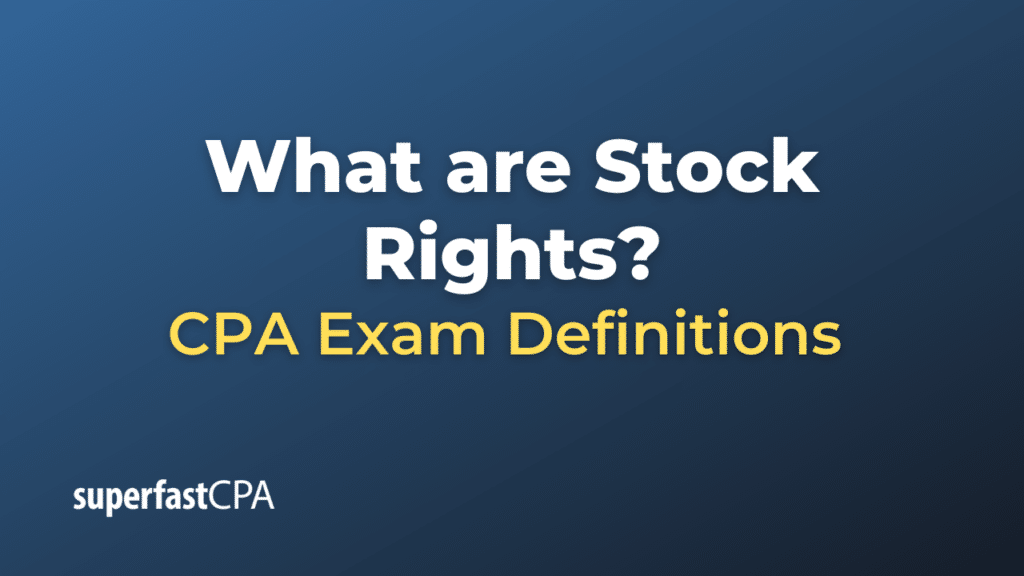Stock Rights
Stock rights, often referred to as “rights offerings” or simply “rights,” are a type of financial instrument issued to existing shareholders of a company. They give shareholders the right, but not the obligation, to buy additional shares of the company at a predetermined price (usually at a discount to the current market price) within a specified time frame. The primary purpose of issuing stock rights is for the company to raise additional capital.
Here’s a breakdown of how stock rights work:
- Proportional Issuance: Rights are typically issued to existing shareholders on a pro-rata basis, meaning shareholders receive rights in proportion to their current shareholdings. For example, a company might issue one right for every ten shares a shareholder owns.
- Exercise Price: The price at which the rights holders can purchase the new shares is called the exercise or subscription price. This price is typically set below the current market price of the shares as an incentive for shareholders to exercise their rights.
- Subscription Period: Shareholders have a certain period during which they can exercise their rights. If they don’t act within this period, the rights will expire and become worthless.
- Tradability: In many cases, rights are tradable, meaning that shareholders can sell their rights on the open market if they choose not to exercise them. This gives shareholders the option to realize some value from the rights even if they don’t want to increase their shareholdings in the company.
- Dilution Protection: Rights offerings help protect current shareholders from dilution. If a company were to issue new shares in the open market without giving existing shareholders a chance to participate, the ownership percentage of existing shareholders would decrease. By offering existing shareholders the right to purchase new shares first, they have the opportunity to maintain their proportional ownership.
- Raising Capital: From the company’s perspective, a rights offering is a way to raise capital without taking on debt. The new shares sold provide fresh funds that the company can use for various purposes such as growth initiatives, paying down debt, or funding operations.
- Over-subscription : Sometimes, if not all shareholders exercise their rights, the company may allow those who are interested to buy more shares than their rights would nominally allow. This is known as an over-subscription privilege.
It’s important for shareholders to understand the terms of a rights offering and make an informed decision about whether to exercise or sell their rights. If they do nothing and let the rights expire, they may experience dilution in their ownership percentage, especially if other shareholders choose to exercise their rights.
Example of Stock Rights
Let’s walk through a simplified hypothetical example to illustrate how a stock rights offering works:
Company B:
- Current Number of Shares Outstanding: 1,000,000
- Current Stock Price: $20
- Shares owned by Shareholder X: 10,000
Now, Company B wants to raise more capital and decides to issue a rights offering.
Rights Offering Details:
- For every 10 shares owned, a shareholder gets 1 right.
- Each right allows the shareholder to buy one new share at $18 (the exercise or subscription price, which is set at a discount to the current market price).
- The rights are valid for one month.
Given the above:
Shareholder X, owning 10,000 shares, will receive 1,000 rights (10,000 ÷ 10). This means Shareholder X can purchase an additional 1,000 shares at $18 per share if he chooses to exercise his rights.
Scenario 1: Shareholder X exercises all his rights.
- He spends $18,000 (1,000 shares x $18/share) to buy the new shares.
- His total shareholding becomes 11,000 shares.
- Company B raises $18 for each new share sold, providing them with fresh capital.
Scenario 2: Shareholder X sells his rights.
- If there’s a market for the rights, he can potentially sell them to other interested investors. The value of each right will depend on the difference between the market price of the stock and the subscription price, among other factors.
- He retains his 10,000 shares but does not increase his position.
Scenario 3: Shareholder X does nothing.
- The rights expire after one month, and he loses the opportunity to buy additional shares at a discount.
- If many other shareholders exercise their rights, Shareholder X’s percentage ownership in the company will be diluted because of the increase in the total number of shares outstanding.
In the real world, numerous other factors might influence the decision to exercise, sell, or let rights expire, such as the company’s future prospects, the shareholder’s view on the stock’s value, liquidity needs, etc. But this simplified example demonstrates the basic mechanics of a stock rights offering.













